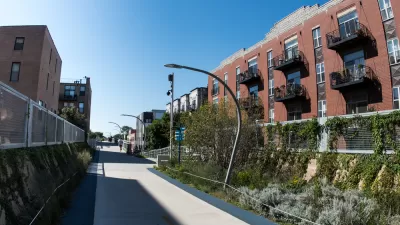Looking a little closer at a city not called New York, San Francisco, or Boston, one writer argues that gentrification is often a good thing.

Pete Saunders follows up a series produced in December by Chicago's public radio station WBEZ that documents gentrification in the city of Chicago. Although Saunders notes many useful qualities found in the series, he also writes, "that it failed to stray very far from the conventional gentrification narratives that, quite honestly, don't fit Chicago all that well."
According to Saunders, "the problem is that the gentrification narrative was established in the cities that experienced the first wave of urban revitalization -- New York, San Francisco, Boston. Too many people have adopted the emotions and mindsets that emerged as those cities went through their revitalization challenges, without considering how unique their own cities' conditions are."
After listing those typical narratives, Saunders goes on to argue, by paraphrasing Gordon Gekko: "gentrification, for lack of a better word, is good." To support that claim, Saunders cites distinctions, sometimes subtle, between immigrant and poor neighborhoods in Chicago, and also raises the question of why black neighborhoods are less likely to gentrify.
If you're looking for more of the recent discussion on the subject of gentrification, John Buntin wrote an article for Slate called "The Myth of Gentrification" that argues for the inadequacy of the term, even making a similar point as Saunders about black neighborhoods along the way.
FULL STORY: "Gentrification, For Lack of a Better Word, Is Good"

Maui's Vacation Rental Debate Turns Ugly
Verbal attacks, misinformation campaigns and fistfights plague a high-stakes debate to convert thousands of vacation rentals into long-term housing.

Planetizen Federal Action Tracker
A weekly monitor of how Trump’s orders and actions are impacting planners and planning in America.

In Urban Planning, AI Prompting Could be the New Design Thinking
Creativity has long been key to great urban design. What if we see AI as our new creative partner?

King County Supportive Housing Program Offers Hope for Unhoused Residents
The county is taking a ‘Housing First’ approach that prioritizes getting people into housing, then offering wraparound supportive services.

Researchers Use AI to Get Clearer Picture of US Housing
Analysts are using artificial intelligence to supercharge their research by allowing them to comb through data faster. Though these AI tools can be error prone, they save time and housing researchers are optimistic about the future.

Making Shared Micromobility More Inclusive
Cities and shared mobility system operators can do more to include people with disabilities in planning and operations, per a new report.
Urban Design for Planners 1: Software Tools
This six-course series explores essential urban design concepts using open source software and equips planners with the tools they need to participate fully in the urban design process.
Planning for Universal Design
Learn the tools for implementing Universal Design in planning regulations.
planning NEXT
Appalachian Highlands Housing Partners
Mpact (founded as Rail~Volution)
City of Camden Redevelopment Agency
City of Astoria
City of Portland
City of Laramie





























